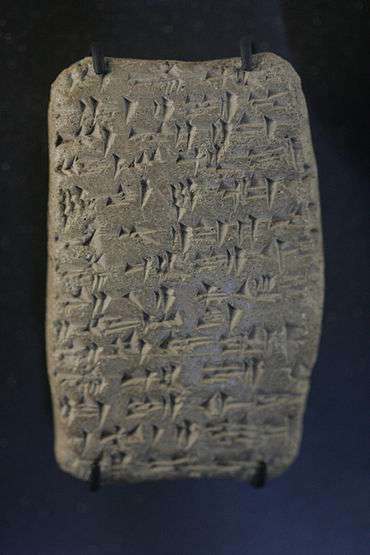Šu


(High Resolution exandable photo)
The cuneiform šu sign is a common, multi-use syllabic and alphabetic sign for šu, š, and u; it has a subsidiary usage for syllabic qat; it also has a majuscule-(capital letter) sumerogram usage for ŠU, for Akkadian language "qātu", the word for "hand".[2] The human hand is the shape of cuneiform character šu, and thus the origin of its creation (late 4th millennium BC, or early 3rd millennium BC).
The scribal usage of a sign allows for any of the 4 vowels (no vowel 'o' in Akkadian), a, e, i, u to be interchangeable; thus a usage for syllabic qat could conceivably be used for the following (k can replace 'q', and d can replace 't'): q, a, or t; also ka, qa, ad, at. (The "š" (shibilant s) is also interchangeable with the other two esses, "s", and "ṣ", for "šu"!)
The šu sign has a common usage in the Amarna letters and the Epic of Gilgamesh. Its usage numbers in the Epic are as follows:[3] qat-(16), šu-(420), ŠU-(13).
References
| Wikimedia Commons has media related to šu (cuneiform). |
- ↑ Moran, William L. 1987, 1992. The Amarna Letters. EA 365, Justified War, p. 362.
- ↑ Parpola, 197l. The Standard Babylonian Epic of Gilgamesh, Glossary, pp. 119-145, qātu, p. 137.
- ↑ Parpola, 197l. The Standard Babylonian Epic of Gilgamesh, Sign List, pp. 155-165, no. 354, p. 161.
- Moran, William L. 1987, 1992. The Amarna Letters. Johns Hopkins University Press, 1987, 1992. 393 pages.(softcover, ISBN 0-8018-6715-0)
- Parpola, 197l. The Standard Babylonian Epic of Gilgamesh, Parpola, Simo, Neo-Assyrian Text Corpus Project, c 1997, Tablet I thru Tablet XII, Index of Names, Sign List, and Glossary-(pp. 119–145), 165 pages.
![]() Media related to Šu (cuneiform) at Wikimedia Commons
Media related to Šu (cuneiform) at Wikimedia Commons
![]() Media related to Cuneiform signs, Amarna letters at Wikimedia Commons
Media related to Cuneiform signs, Amarna letters at Wikimedia Commons